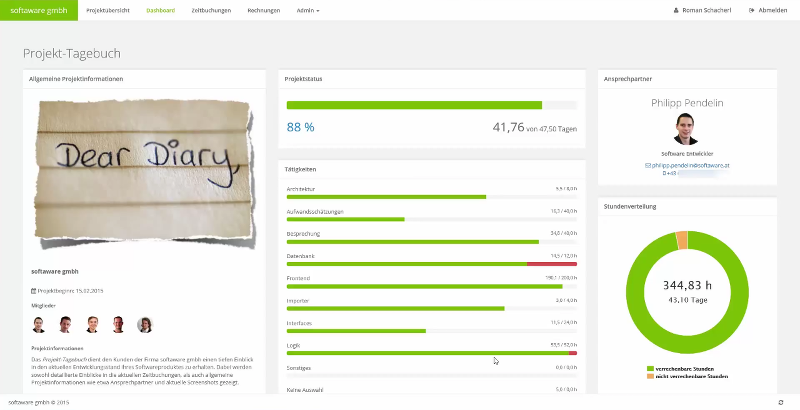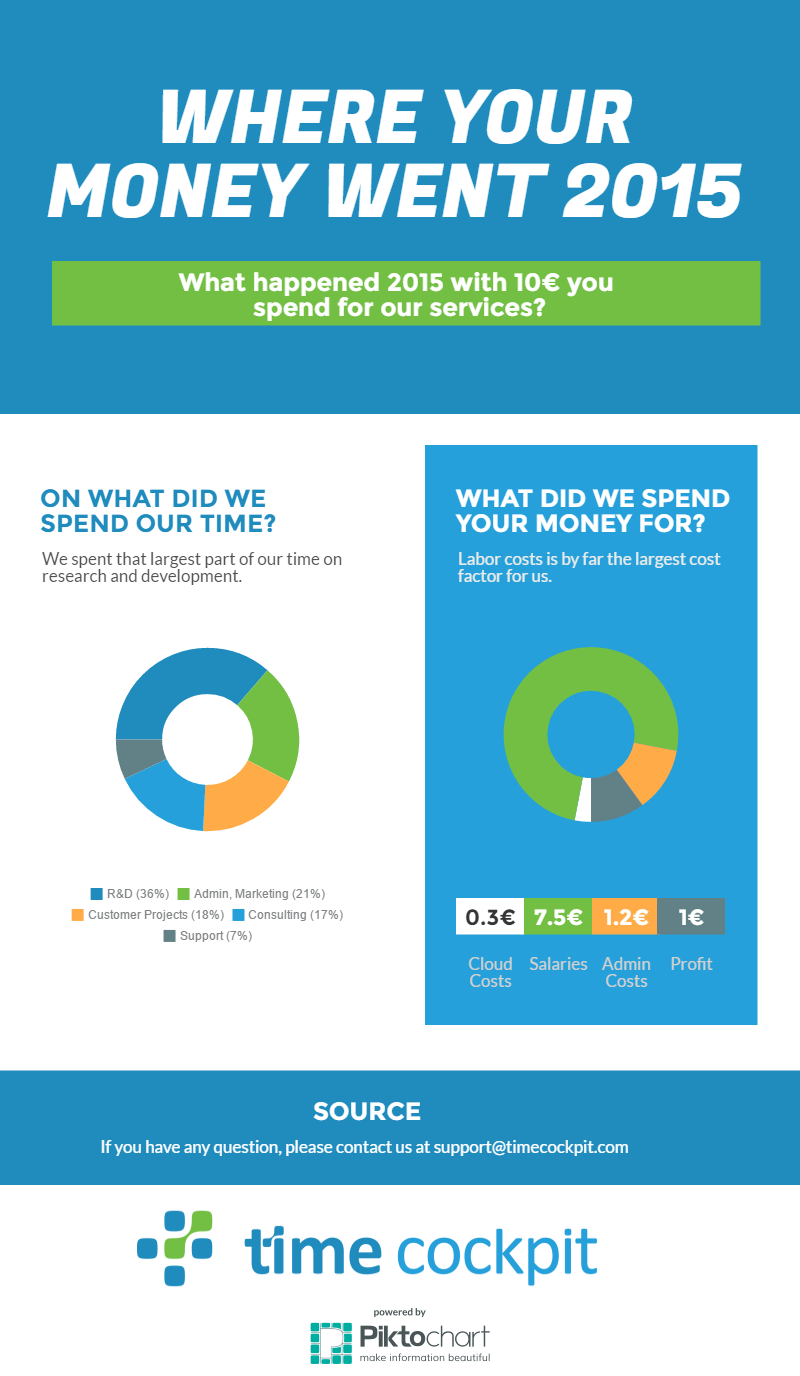
Image source: https://flic.kr/p/bBHv54, Creative Commons License
In time cockpit implementation projects, we get in touch with very different company cultures. In Western European countries like Germany and Austria we always have to deal with two critical topics: Data security and working time regulations. Typically, a large fraction of the customizing effort is invested in these two aspects of time cockpit. Customers take this for granted, they are used to it. But does it always have to be like that? Are there successful examples of completely different approaches?
All our Data has to be Protected!
When we first speak with customers and prospects, they typically emphasize how important data security is. Here are some examples of things we hear:
- We don't use cloud-based SaaS because our time tracking and project data must not get into the hands of external service providers.
- We need field-level permissions so that only team managers can see the salary of team members.
- We need sophisticated row-level permissions so that each employee can only see the projects she is involved.
- Customers only get aggregated information. They must not have access to the details.
In my opinion, overrating security and aiming for utmost secrecy comes at a price. Projects are expensive, innovation is slowed down, people sometimes get frustrated, etc. Don't get me wrong. I am not saying that having no data security mechanisms at all is a good thing.
However, we have to classify our data and question old habits about nondisclosure. Our goal has to be to focus security efforts so that resources can be invested in adding value for customers and protecting the data that is really worth it.
Dealing with Working Time Regulations is Most Important, isn't it?
In my opinion, working time regulations have become a sacred cow in many Western European countries. As companies, we are forced to limit the working time flexibility for our employees to a great extent. Again, I am not saying that we should totally deregulate working time. Regulations are important for branches and job types where employers have much more power than employees. For many of our customers (e.g. in the IT branch) this is not the case. They are struggling to get enough high-skilled employees. In addition to that, people working in IT are typically well educated and demand a high level of flexibility.
In my opinion, work results should count much more than when and how long somebody worked. Legislator and trade unions should give companies more room to design flexible working models together with their employees. As mangers we should use the room that todays labor laws give us to find working time models that fit to our teams' cultures.
Time cockpit includes a lot of features concerning working time models, maximum working time, vacation management, etc. that support you in documenting compliance with working time regulations.
Additionally, time cockpit is extensible and customizable to a great extent so you can tailor it to your company-specific rules.
Black Swans
All swans are white. That's what people had been sure of in the "old world" until 1697. In that year, a Dutch explorer discovered black swans in Western Australia. Before, the term "black swan" was used as a metaphor to describe something that simply cannot exist (more about the Black Swan metaphor).
The author Nassim Nicholas Taleb wrote a book called "The Black Swan: the impact of the highly improbable". It influenced my thinking about risk management, project planning, financial planning, contract design, etc. a lot. I recommend it to everybody who has to deal with these topics.
There are examples of companies taking different approaches, some of them even radically new ones. They are "black swans" concerning openness, transparency and autonomy of employees. Let's take a look at some examples.
Buffer
Buffer is a company offering social media management for marketers and agencies. The company consists of 70 people and their software is used by more than 3 million customers (source). For me, Buffer is so amazing because their organizational structure and openness is radically different. Here are some examples with hyperlinks to more detailed information about the different aspects:
- Buffer's team is distributed all over the world (see Buffer's time-zone map). The employees can freely choose their working place (at home, coffee shop, co-working space, etc.). Read more...
- Buffer has explicitly written down their 10 core values (details). Transparency, self-improvement, working smarter instead of harder, and valuing good solutions over short-term profit are all present in their top 10.
- Transparent salaries not only within the company but even in public. Buffer calculates salary based on a public formula. There is even a salary calculator app on the internet. Read more...
- Buffer has a public(!) dashboard where you can watch charges, cancellations, payments, etc. in real time.
These are just examples of things that differentiates Buffer from other companies.
I encourage you to take a look at Buffer's blog where you can read more about Buffer's motivation.
Unfortunately, an organization like Buffer would not be possible in our home country Austria. Legal regulations forbid that level of flexibility and self-organization. However, there are still aspects in Buffer's culture that can be implemented despite strict working time laws even in countries like Austria.
Softaware
Softaware is one of our closest partners and a long-term time cockpit user. The softaware team is based in Austria and currently consists of 12 people. They create custom software solutions for medium and large customers based on Microsoft-technology. The softaware founders are passionate about technology. Software quality and innovation based on cutting-edge technology are two of their most important values.
Last year, softaware decided to fundamentally change the communication with customers during projects. They created a "Project Diary" that allows customers to directly look into softaware's backend systems. Invested effort and project progress is fully transparent for the customers. No more juggling around effort between projects and tasks at the end of the month, no more hiding of technical challenges slowing down projects, etc. With the Project Diary, softaware wants to raise the involvement of stakeholders and to build trust based on transparency. Roman Schacherl, co-founder and CEO of softaware, describes:
"Our ambition is a fair partnership with our customers, and transparency is mandatory. Nevertheless, it is a day-to-day challenge: “we’ve estimated 2 days but then finished in 6 hours – what to do?” The answer is easy: earn money for 6 hours. It might be a financial drawback first, but in the long term you’ll win."

If you want to learn more about softaware's project diary and how they used time cockpit as one of its backend systems, read our blog article Differentiate with Transparency.
What We do at Time Cockpit
Transparency is an important value in our company, too. Here are some concrete examples of consequences:
- Sharing knowledge with the community is very important for us
We freely share our technological approaches (e.g. thoughts about software architecture, code samples, tips and tricks, etc.) in our blog, on GitHub, in magazine articles, and in dozens of talks each year at community conferences. - Transparent salary and financial data
We do not keep our financial data secret inside the company. Everybody knows about revenue, costs, salaries, profits, etc.
- Transparent communication
We don't have a complex permission system concerning internal and external communication. Everybody in our company has e.g. access to our entire support communication with customers without limitation based on some kind of customer-ownership. All team members have full access to our source code. - Capped project costs with detailed time sheets
When we do projects with customers, we always try to offer time & material contracts with capped costs so that customers know the maximum costs upfront. We share detailed time sheets including time for non-billable bugfixing, administration, etc. with our customers so that they keep updated on how much effort we spend. - Transparency about our cloud usage
In our online help, our blog and our conference talks we describe in detail which cloud services our software is based on, which data center we use, etc. We think that this openness is an important trust-building factor.
We see traceability as an important enabler of transparency.
By using professional SaaS-solutions for work item management, source control, build automation, continuous deployment, support, etc. we can ensure that "secret" changes are made or "silent" communication takes place in the background.
While writing this blog article, I realized that we rarely speak about our internal cost structure in public. It is not a secret, so I took our numbers for the last calendar year and created the following infographic. I hope you find it interesting. If you want to see the interactive version, open the infographic Where Your Money Went 2015.

Questions? Feedback?
Do you have questions about our technology, our processes, our team or something like this? Feel free to contact us at support@timecockpit.com. We are looking forward to having a chat with you!
comments powered by